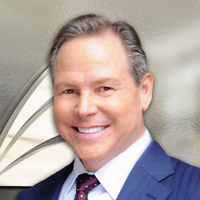Build Your Retirement Plan With a Strong Fiscal Foundation
You need to develop a strategy that can get you to and through retirement.

When people dream about retirement, they think about the things they'll do, the places they'll go, the people they'll see.
Unfortunately, too often what they don't think about is how they're going to pay for all that.
They've got Social Security coming, maybe some savings, a 401(k) from work and perhaps a pension—but no real idea of how far that will stretch or what their future may require.
From just $107.88 $24.99 for Kiplinger Personal Finance
Be a smarter, better informed investor.

Sign up for Kiplinger’s Free Newsletters
Profit and prosper with the best of expert advice on investing, taxes, retirement, personal finance and more - straight to your e-mail.
Profit and prosper with the best of expert advice - straight to your e-mail.
Instead, they'll pick out an age. "I'm going to retire at 67," they'll say, without any plan for how that's going to happen.
But no one can say with 100% certainty what their life is going to look like five years out, much less in 10 or 20 years. And some people retiring in their 60s could live for another 25 or even 30 years. So the number you really have to know isn't how old you'll be when you retire—it's how much you'll need.
Then you and your financial adviser can develop a strategy to help you work toward that number.
In this way, a financial adviser is like an architect, creating a "retirement blueprint" for you based on your individual needs and goals. With such a blueprint, your adviser can better assist you with charting out a retirement that matches your vision for your later years.
A lot of the people I meet with know what they want their retirement to look like, and they're working on acquiring what they need to build it, but they don't have that blueprint to put the whole thing together. They don't have a structured way of drawing down certain assets, implementing cash flow on others, dealing with inflation and taxes or assuring asset protection if someone needs long-term care.
Instead, like so many people who are nearing or in retirement, they have a sort of "kitchen junk drawer" of retirement products that they've accumulated over the years, but with no overarching strategy that can help them work toward achieving the secure and satisfying retirement they desire.
The first conversation you have with your financial adviser lays the cornerstone, so treat it like an interview. Talk to more than one adviser until you find a connection, and make sure it's about developing a strategy, not focused solely on products.
One thing I like to do with new clients is run a Morningstar report early on for a 10-year look back at their current investment mix. This will give them a window into the past and an opportunity to see how their portfolio behaved during certain market cycles. Then we can look at the sort of behaviors a different plan would have compared with the plan they're using.
Financial vehicles—such as fixed annuities with guaranteed lifetime income riders and single premium immediate annuities—that guarantee steady, safe cash flow should make up the foundation of your fiscal house. Those guarantees, of course, are backed by the financial strength of the issuing insurer. Then you can sprinkle in certain amounts of risk, depending on your tolerance. (I like to lean on the Rule of 100, which uses age to determine asset allocation. For example, if you're 50, 50% of your money should be in safer investments and 50% would be a bit riskier. At 65, 65% should be safe. And so on.)
A good adviser will make sure the strategy is designed to evolve with you in your golden years. If you need to turn on a dime because of a life change, you'll have the flexibility to do that. And as you go, he or she can help you find the tools to help fill gaps in your retirement plan.
You'll make decisions based on information instead of emotion. Your adviser will focus on creating a strategy for you, not solely on products.
The goal is to build a cohesive strategy together that is designed to help you keep the lifestyle you had before retirement. Or, better yet, potentially provide you with the lifestyle of your dreams.
Kim Franke-Folstad contributed to this article.
Investment advisory services offered only by duly registered individuals through AE Wealth Management, LLC (AEWM). AEWM and Solutions First, Inc. are not affiliated companies. The appearances in Kiplinger were obtained through a PR program. The columnist received assistance from a public relations firm in preparing this piece for submission to Kiplinger.com. Kiplinger was not compensated in any way.
Profit and prosper with the best of Kiplinger's advice on investing, taxes, retirement, personal finance and much more. Delivered daily. Enter your email in the box and click Sign Me Up.

Joseph Donti is a Registered Investment Advisor at Safeguard Investment Advisory Group. He runs the Arizona office alongside his wife, Patty Donti, and is committed to helping families create amazing retirements and find lasting financial confidence. He has passed his Series 65 exam and holds life and health licenses in Arizona and California.
-
 Quiz: How Well Do You Know Delaware Statutory Trusts?
Quiz: How Well Do You Know Delaware Statutory Trusts?Quiz Real estate investing pro Daniel Goodwin recently wrote about Delaware statutory trusts for Adviser Intel. Find out if you understand how DSTs work.
-
 S&P 500 Snaps Losing Streak Ahead of Nvidia Earnings: Stock Market Today
S&P 500 Snaps Losing Streak Ahead of Nvidia Earnings: Stock Market TodayThe Dow Jones Industrial Average also closed higher for the first time in five days, while the Nasdaq Composite notched a win too.
-
 This HECM-QLAC Power Move Can Unlock Guaranteed Retirement Income
This HECM-QLAC Power Move Can Unlock Guaranteed Retirement IncomeCombining a qualified longevity annuity contract (QLAC) with a home equity conversion mortgage (HECM) can significantly boost your retirement income and more.
-
 I'm a Financial Planner: Coast FI Planning Could Be High Earners' Secret Retirement Weapon in the AI Age
I'm a Financial Planner: Coast FI Planning Could Be High Earners' Secret Retirement Weapon in the AI AgeA subset of the FIRE movement, Coast FI can help executives figure out whether their investments are enough to 'coast' so they can retire early and comfortably.
-
 The Private Annuity Sale: A Smart Way to Reduce Your Estate Taxes
The Private Annuity Sale: A Smart Way to Reduce Your Estate TaxesIn a private annuity sale, you transfer a highly appreciated asset to an irrevocable trust in exchange for a lifetime annuity.
-
 These Eight Tips From a Retirement Expert Can Help to Make Your Money Last Through Retirement
These Eight Tips From a Retirement Expert Can Help to Make Your Money Last Through RetirementAre you worried you will outlive your money? Considering these eight tips could go a long way toward ensuring your retirement money lasts as long as you do.
-
 I'm an Investment Adviser: This Is the Retirement Phase Nobody Talks About
I'm an Investment Adviser: This Is the Retirement Phase Nobody Talks AboutWhat you do in the five years before retirement and the first 10 afterward can establish how comfortable you'll be for the rest of your life.
-
 Gen X Turns 60: It's Time to Remix Your Retirement Playlist
Gen X Turns 60: It's Time to Remix Your Retirement PlaylistIf you want a worry-free retirement, you can't keep playing the same old song. You need to freshen up your financial strategies, as well as your music.
-
 I'm a Financial Adviser: Here's How a Three-Part Retirement 'Crash Plan' Can Prepare You for Market Turbulence
I'm a Financial Adviser: Here's How a Three-Part Retirement 'Crash Plan' Can Prepare You for Market TurbulenceHaving a plan ready to go when markets get wild — covering how you'll handle income, rebalancing and taxes — can be the ultimate retirement secret weapon.
-
 Here's How to Plan This Year's Roth Conversion, From a Wealth Manager
Here's How to Plan This Year's Roth Conversion, From a Wealth ManagerWhile time is running out to make Roth conversions before the end of the taxable year, consider taking your time and developing a long-term strategy.